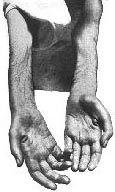What is ALS?
The only things that
are known about Amyotrophic Lateral Sclerosis (ALS), a syndrome which has been
around since the time of the Civil War, are its effects on the
body. When ALS  affects motor neurons, the axon of that neuron,
surrounded by Schwann cells of the myelin sheath, begins to collapse.
Eventually, the entire motor neuron will degenerate. As the axon breaks
down, the waste, neurofilament
buildup, accumulates around the nucleus of the cell and causes malfunctioning.
The Schwann cells insulate the neurons;
as they stop working, control is lost over certain muscles. This loss of
control causes eventual paralysis and
death.
affects motor neurons, the axon of that neuron,
surrounded by Schwann cells of the myelin sheath, begins to collapse.
Eventually, the entire motor neuron will degenerate. As the axon breaks
down, the waste, neurofilament
buildup, accumulates around the nucleus of the cell and causes malfunctioning.
The Schwann cells insulate the neurons;
as they stop working, control is lost over certain muscles. This loss of
control causes eventual paralysis and
death.
When these motor
neurons die, the brain or spinal cord can no longer control the muscles that
each motor neuron affects, leading to atrophy. This usually starts in the
legs, hands, or vocal chords, but the symptoms are different for each
patient.
Scientists and researchers have proposed
several theories to explain ALS. One
conjecture is that certain environmental toxins trigger this syndrome, due
to the fact that some places with high pollution sometimes have higher incidence rates of ALS. Many researchers also think it
may be an autoimmune disease, where the body’s own antibodies attack the body by
mistake. However, this theory is unsubstantiated as well. Scientists have already found a specific
genetic mutation that could be responsible for familial ALS, where
numerous other family members are also diagnosed with the syndrome, but this
form is found in only one-fifth of the total patients who have ALS. Genes seem to trigger some
familial forms of
ALS. In 1993, researchers found a gene in chromosome 21, ALS2, which causes one
form. Healthy ALS2 genes kill free radicals, which are very reactive
short-lived molecules that have one or more unpaired electrons. Free radicals
are products of cell processes and are very harmful to cells. Scientists think
that a mutated form of the gene kills chains of nerve cells.
This picture shows the hands of a person who has ALS.
have higher incidence rates of ALS. Many researchers also think it
may be an autoimmune disease, where the body’s own antibodies attack the body by
mistake. However, this theory is unsubstantiated as well. Scientists have already found a specific
genetic mutation that could be responsible for familial ALS, where
numerous other family members are also diagnosed with the syndrome, but this
form is found in only one-fifth of the total patients who have ALS. Genes seem to trigger some
familial forms of
ALS. In 1993, researchers found a gene in chromosome 21, ALS2, which causes one
form. Healthy ALS2 genes kill free radicals, which are very reactive
short-lived molecules that have one or more unpaired electrons. Free radicals
are products of cell processes and are very harmful to cells. Scientists think
that a mutated form of the gene kills chains of nerve cells.
This picture shows the hands of a person who has ALS.
 affects motor neurons, the axon of that neuron,
surrounded by Schwann cells of the myelin sheath, begins to collapse.
Eventually, the entire motor neuron will degenerate. As the axon breaks
down, the waste, neurofilament
buildup, accumulates around the nucleus of the cell and causes malfunctioning.
The Schwann cells insulate the neurons;
as they stop working, control is lost over certain muscles. This loss of
control causes eventual paralysis and
death.
affects motor neurons, the axon of that neuron,
surrounded by Schwann cells of the myelin sheath, begins to collapse.
Eventually, the entire motor neuron will degenerate. As the axon breaks
down, the waste, neurofilament
buildup, accumulates around the nucleus of the cell and causes malfunctioning.
The Schwann cells insulate the neurons;
as they stop working, control is lost over certain muscles. This loss of
control causes eventual paralysis and
death. 